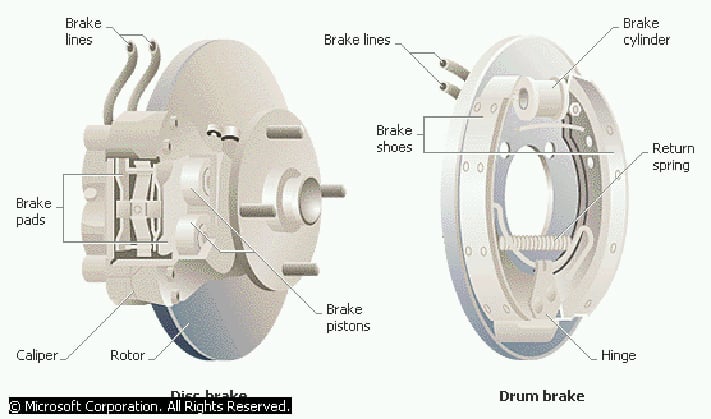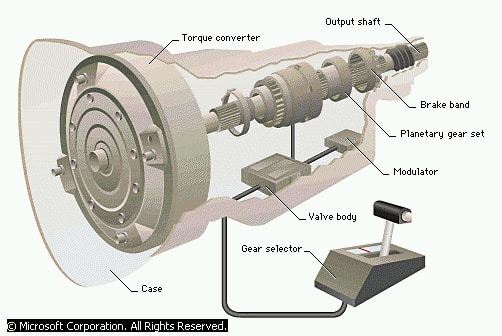Cars have many devices to help them accelerate and reach a certain velocity, but slowing down the automobile is a very important function to achieve as well. Two ways cars are able to slow down their velocity is through the ability of the transmission to downshift and the brakes using friction to make the wheels come to a stop.
The brake’s main purpose is to bring the car to a complete halt by gradually slowing them down. They achieve this by using friction between a wheel and another object to stop the vehicle. Most passenger vehicles use a braking system known as the hydraulic braking system, which uses a liquid (brake fluid) to push pistons which in turn transmits pressure to each of the four individual brakes.
When pressure is put on the brake pedal, “the brake fluid travels from the master cylinder to the wheels through a series of steel tubes and reinforced rubber hoses (Ofria, 2000)” and eventually pushes pistons that are connected to the brakes on each wheel. and depending on the pressure exerted on the brake pedal; the car will either slow down or come to a complete stop.
“The components of a drum brake are housed in a round drum that rotates along with the wheel. Inside was a set of shoes that, when the brake pedal was pressed, would force the shoes against the drum and slow the wheel. Instead of housing the major components within a metal drum, disc brakes use a slim rotor and small caliper to halt wheel movement. Within the caliper are two brake pads, one on each side of the rotor, that clamp together when the brake pedal is pressed. (Brauer. 2004)”
“An automatic transmission is designed to automatically adjust its gear ratios according to a vehicle’s acceleration and road speed, and the strain on the engine.” (Fetherston, 2001) Engine power is transferred to the gearbox by a torque converter which is filled with a liquid called transmitter fluid. When an object called the impeller starts turning, it causes the turbine in the transmission to turn. causing the gearbox’s input shaft to rotate.
“Turbine speed lags behind impeller speed during acceleration, but the two eventually run the same speed. (Fetherston, 2001)” Gears are shifted by the pressure created by the impeller on the transmission liquid (hydraulic pressure). A valve moves pistons that hold the clutches and bands (material that holds the gears in place) of the gears and depending on the pressure moves the gears up and with less pressure moves them down, thus slowing the car down.
Although the car holds many tools to make it run, some of the most important parts are the ones that allow the car to slow down its velocity and eventually come to a stop. The brakes and transmission both use hydraulic pressure to slow down the velocity, while the brakes use friction and the transmission uses the pressure to downshift when the pressure goes down. Without these vital parts in the car, slowing the car down and coming to a complete halt would be a very difficult task to accomplish.
Work Cited List
Brauer, C. (2004). Brakes: Drum vs. disc. Retrieved October 6, 2004, from http://www.edmunds.com/ownership/techcenter/articles/43857/article.html
Carley, L. W. Automobile brakes. (2001) Microsoft Encarta Encyclopedia Deluxe 2001, from Encarta 2001
Erjavec, Jack. (1998). Today’s technician: Automotive automatic transmission and transaxles. Boston: Delmar Publishing
Fetherston, D. Transmission: Automotivec. (2001) Microsoft Encarta Encyclopedia Deluxe 2001, from Encarta 2001
Johanson, C. & Stockel, M. T. (2001). Auto brakes technology. Chicago: Goodheart Wilcox Company
Nice, K. (2000a). How automatic transmissions work. Retrieved October 2, 2004, from http://auto.howstuffworks.com/automatic-transmission.htm
Nice, K. (2000b). How brakes work. Retrieved October 2, 2004, from http://auto.howstuffworks.com/brake.htm
Ofria, O. (2000). A short course on brakes. Retrieved October 3, 2004, from http://www.familycar.com/brakes.htm



As a background from Mechanical engineer this blog was very useful with information stuff. Keep writing such articles. Looking forward for more post.Thanks
nice